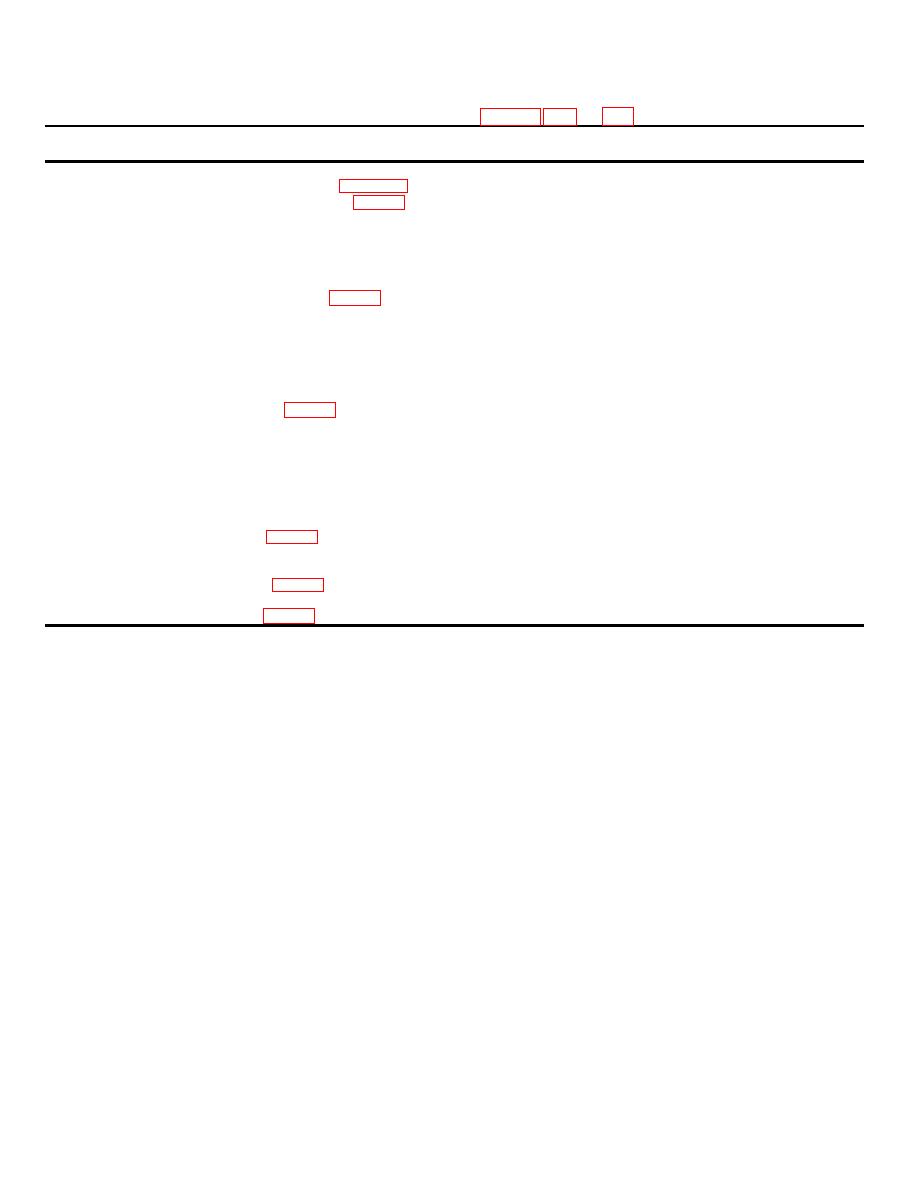 |
|||
|
|
|||
|
Page Title:
Table 7-2. Application of Materials for Blocking and Tiedown of the M973 on a General Purpose Flatcar (Figs 7-1, 7-2, and 7-3... |
|
||
| ||||||||||
|
|
 TM 55-2350-272-14
Table 7-2. Application of Materials for Blocking and Tiedown of the M973
on a General Purpose Flatcar (Figs 7-1, 7-2, and 7-3).
No.
Item
Req.
Application
A
Brake wheel clearance. Minimum clearance required is 6 inches above, in back of, and on both sides of, and 4
inches underneath wheel (figure 7-1).
B
4
Forward track chocks (detail 2, fig 7-3). Each consists of five pieces of 2- X 10-inch lumber nailed together with
12d nails, or pieces may be cut from 8- X 10-inch lumber. Solid chocks cut from 8- X 10-inch lumber are re-
quired by Alaskan railroads. Place one chock firmly against the center of each track at the forward end of each
unit. Toenail with three 30d nails in each side.
C
8
Backup cleats. Use two pieces of 2- X 6- X 18-inch lumber. Place against the heel of each track chock, items B
and D. Nail the bottom pieces with three 30d nails.
D
4
Rear track chocks (detail 3, fig 7-3). Each consists of five pieces of 2- X 10-inch lumber nailed together with 12d
nails or pieces may be cut from 8- X 10-inch lumber. Solid chocks cut from 8- X 10-inch lumber are required
by the Alaskan railroads. Place one chock firmly against the center of each track at the aft end of each unit.
Toenail with three 30d nails in each side.
E
4
Barrier material. Place barrier material on the railcar and against the tracks.
F
4
Side blocking. Each consists of two 2- X 4- 72-inch lumber. Place on tope of and against barrier material and
firmly against the track. Nail the bottom pieces with ten 30d nails and the top piece with ten 30d nails.
G
5
Wire rope (detail 4, fig 7-3). Each consists of -inch wire rope, length as required. Form a complete loop be-
tween the front units'forward tiedown fixture and the right stake pocket on the flatcar. Form a complete loop
between the front units'forward tiedown fixture and the left stake pocket on the flatcar. Place one complete
loop from the left stake pocket on the flatcar over the lower support arms between the units, tot he right stake
pocket on the flatcar. Secure a 2- X 4- X 10- inch wooden block between the wire rope and each support arms
so that the wire does not contact the support arms when wire is tensioned. Form a complete loop between the
rear units'pintle and the right stake pocket on the flatcar. Form a complete loop between the pintle on the left
stake pocket of the flatcar. Tension all tiedowns evenly and secure with four cable clamps, item H.
H
20
Clamps (detail 4, fig 7-3). Place four -inch clamps on each wire loop at the overlap area and space each clamp
3 inches apart, with a minimum of 6 inches from each end of the wire rope. After placement of thimble (item I)
at the stake pocket, tension wire rope and tighten clamps from 20- to 25-foot-pound torque.
I
6
Thimbles (detail 5, fig 7-3). Place one -inch thimble between the wire rope and the stake pocket and secure with
item J.
J
6
GENERAL INSTRUCTIONS
1.
Wooden blocks (2- X 4- X 10-inch) must be used to protect the support arms of the articulation drive assembly
between the two units of the M973. Secure wire rope to wooden block by driving a 12d nail half way and bending the nail
over the wire rope until the head of the nail contacts the wood.
2.
Tensioning of wire rope can be accomplished with an applicable sized come-along mechanical hoist or equal
tensioning device.
3.
When the M973 is in the tiedown position, place the transmission control in neutral and set parking brakes.
4.
Loading Rules 1A, 2, 3, 4, 5, 9, 14, 15, and 19A in Section No. 1 of the Rules Governing the Loading of Com-
modities on Open-Top Cars and Trailers, published by the Association of American Railroads, provide applicable guide-
lines and are mandatory in application.
Section III. TRANSPORT ON FOREIGN RAILWAYS
7-6.
General
The transportability guidance contained in this section is applicable when the M973 is transported on foreign railways.
Consideration is given to single and multiple movements on the types of railcars normally used for the transport of this
type of vehicle. The M973. when loaded on a suitable flatcar, can be transported, with restrictions, within European
countries complying with the passe-partout international (PPI) gauge railways. Because of the various designation sys-
tems used by different countries, foreign railcars are difficult to classify. In addition, clearances may very between coun-
tries and within a country. Consequently, evaluation of transport capability must be made o an individual basis.
7-7.
Transport on Foreign Service Flatcars
The M973 can he transported on a number of foreign service flatcars The materials required for blocking and tiedown on
foreign service flatcars are essentially the same as those used in CONUS Dimensions, load capacity, and other data for
several flatcars available in Europe, as well as detailed guidance for securing vehicles on these cars, are contained in
4TH TRANSCOM Pamphlet 55-2, Tiedown Guide for Rail Movements, 15 May 1982.
7-4
|
|
Privacy Statement - Press Release - Copyright Information. - Contact Us |